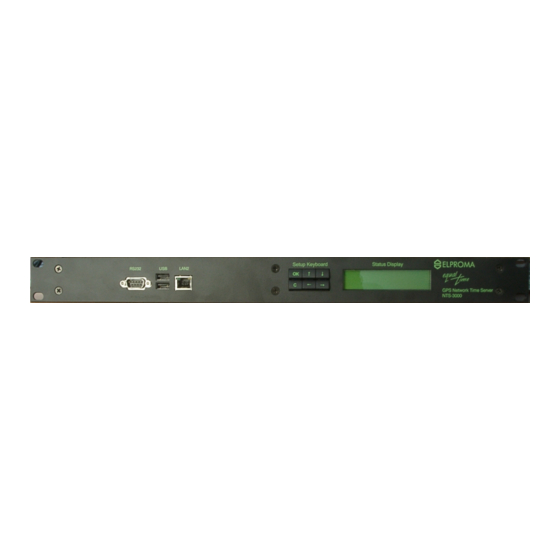
Advertisement
Quick Links
Description of GPS antenna and NTS time server connection via
SAFETY INSTRUCTIONS !
This are the important Safety Instructions that should be followed during installation and
maintenance of the ELPROMA NTS-protect overvoltage system.
IMPRTANT NOTE !
This equipment contains hazardous voltages. Do not handle any metallic part until the
power has been disconnected. Do not assemble, disassemble set when the power is ON.
Making wiring and touching cables is strongly prohibited when power is ON. Please refer
your RACK'19 safety instruction to learn more on connecting power of equipment. The
NTS-protect system requires PE line to be connected into RACK'19 din rails.
Electrical Safety:
1. Do not work alone under hazardous conditions.
2. High short circuit current trough conductive materials could cause severe burns.
3. Check that the power cord(s), plug(s), and sockets are in good conditions.
4. Use qualified service personnel to install permanently wired equipment.
5. Do not handle any metallic part before the power has been disconnected.
NTS-protect
system lightning protector system
/NTS-3000, NTS-4000, NTS-5000/
© 2008 ELPROMA Electronics
Advertisement

Summary of Contents for Elproma NTS-4000
- Page 1 /NTS-3000, NTS-4000, NTS-5000/ SAFETY INSTRUCTIONS ! This are the important Safety Instructions that should be followed during installation and maintenance of the ELPROMA NTS-protect overvoltage system. IMPRTANT NOTE ! This equipment contains hazardous voltages. Do not handle any metallic part until the power has been disconnected.
- Page 2 Introduction The GPS (DCF77) antenna located on the building roof is connected to a GPS/DCF77 module situated nearby. This module is connected to a remote NTS (models: NTS-3000, NTS-4000, or NTS-5000) server via lightning protector system (NTS-protect unit). This system is a unit of overvoltage and lightning protection preventing the NTS server from direct and indirect effects of atmospheric discharges.
- Page 3 All in/out lines of the NTS server have been conducted through overvoltage limiters mounted altogether on the steel-made DIN35/7,5mm bus, a standard solution applied to industrial automatics for rack’19 switchboxes. The height of the solution is 2U and it is mounted inside the rack’19 switchbox, e.g.
- Page 4 The NTS server communicates with the GPS/DCF antenna module via low-signal circuits of the voltage levels not exceeding 12V. The transmission is carried out through a standard Cat5 ethernet twisted pair cable, cramped into RJ-45 connectors in TIA-568B scheme. The cable has two lines (brown, white-brown wires) providing power supply to the antenna module.
- Page 5 NTS-3000 server and LAN/WAN network with standard Cat. 5 wires. The length of wires along the “NTS-3000 server – lightning protector” track should be of the least possible value. The lightning protector is mounted onto a DIN35/7,5mm bus whilst its protection wire is linked to the protection circuit (yellow and green wire) through a special cramp on the rack.
- Page 6 Description of power supply system protection 230V AC (VAL-MS 230ST limiters) Rack’19 NTS-protect NTS server DIN35/7,5mm (Rack’19 rails) bottom Due to wide scope of applications and high efficiency as well, the system has been assumed to be provided with the protection made for the entire rack’19 switchbox. Then the issue to discuss is barely the way the power is distributed inside the rack’19 switchbox (it refers to the number of internal outlets mounted onto the bus) and not the way of supplying the power to the entire rack’19 switchbox along its appropriate grounding system (PE line).
- Page 7 3. All wires connected to the protection systems should be of the least possible length. NOTE ! Remember that the NTS-3000 unit only minimizes the probability of damages resulting from overvoltage and arising directly or indirectly as a consequence of atmospheric discharges, however, it provides no absolute warranty against overvoltage.
- Page 8 APPENDIX Technical specification...




Need help?
Do you have a question about the NTS-4000 and is the answer not in the manual?
Questions and answers